| |
|
|
|
|
Colonial Family Quick Links
|
|
|
|

|
|
|
|
|
Family C-3: Cutty Sark
 |
This still-active family descends from a chestnut throughbred mare, Cutty Sark, that arrived in Australia on the Prince Regent in March, 1826, having been shipped out from England with a stallion and four other mares, and sheep, for the Australian Agricultural Company. Three of the mares died enroute, but Cutty Sark, the mare Spaewife, both in foal, and the stallion Peter Fin survived. Unfortunately the pedigree ascribed to Cutty Sark-- by Oxford, and out of a mare by Fidget, her second dam by Dragon, could not be confirmed, despite the efforts of many over the years [Barrie, The Australian Bloodhorse, pp. 207-8, offers a plausible alternative], and she was therefore not admitted to the Stud Book, but when, 140 years after her importation into Australia, the American Stud Book and General Stud Book amended their requirements for admission for colonial families in 1965, the Cutty Sark family finally became eligible for entry into the Australian Stud Book.
The disposition of the Cutty Sark foal imported in-utero is unknown. She was then bred to the imported stallion Herald, producing a colt the following year, 1827, bred by the Australian Agricultural Company, and then advertised for sale, whose fate is likewise unknown. In 1830 she produced a foal of uknown sex by imported Peter Fin. In 1831 or 1832 she bred Bonnie Lass (by imported Bachelor), followed the next year by a sister, Bett Hyatt (1833). These fillies were followed by a foal of unknown sex by imported Skeleton. Cutty Sark and her daughters Bet Hyatt and Bonnie Lass were purchased at the 1834 Australian Agricultural Company dispersal sale by Charles Smith, who bred the rest of her foals: Deception (1836) and Woodpecker (1839) by imported Theorem; Troll (1840, by imp. Lawson's Emigrant); Tros (1842, by imported Tros); Cain (1843) and Marske (1844), both by Vagabond.
According to historian Keith Binney, Charles Smith had been a groom in Shropshire, convicted for pick-pocketing, and transported on the Baring to Sydney, arriving in 1819. In Sydney he did well as a servant for various military officers, and was granted an early Ticket of Leave, and then a conditional pardon, in 1830. He made his money as a butcher in Sydney, which included a government contract to provide sailing vessels with salted meat, and he also built up a good practice in the wholesale cattle business. He became a keen city and bush racing supporter, and in 1832 purchased the 2,000 acre Bungarribee station along Eastern Creek, gradually enlarged by government grants and grazing licenses. He later purchased other properties, including Abbotsbury, near Prospect, Bayly Park, at South Creek, and Clifton, near Windsor, where he moved some of his bloodstock in the early 1840s.
Smith became the most prominent owner and breeder of racehorses in his time. He owned a number of famous runners, and purchased or bred some of the best-known of the early colonial stallions and their progeny. He bought the famous Rous' Emigrant (1822) at an auction held to terminate the syndicate formed by Henry Rous to import the horse in 1834, and the stallion Theorem (1824), who had been imported with Emigrant. The stallion Speculation, imported in 1839, and The Doctor, imported in 1842, were owned by Smith. Emigrant, Theorem, The Doctor, and Emigrant's sons, Zohrab and Gohanna, figure in the development of the Cutty Sark family. Smith was responsible for breeding many important early stallions, including the Rous' Emigrant sons Young Rous' Emigrant and Charles O'Malley; the Speculation sons Speculation and Whalebone; the Theorem son Barefoot; and the famous Sir Hercules, from the imported mare Paraguay and by the imported Cap-a-Pie.
Bonnie Lass, Bet Hyatt, and Deception, from whom the Cutty Sark family descends, were bred by Smith. It is believed that Cutty Sark died in 1844, soon after foaling her last colt, Marske. Smith died in January of 1845, and his bloodstock were disposed of in a dispersal sale in February of that year.
Of Cutty Sark's offspring, the filly Troll and the colt Tros were both sent on the Henrietta to Calcutta, India, in 1844 by Smith, along with nine other horses owned by him, and twelve owned by breeder Charles Roberts, intending to use the sales proceeds to buy exotic animals for a zoo, but Smith died within a year and the plan was never effected. Neither Cain nor Marske made much of a dent on the turf or in the stud. But Cutty Sark's daughters Bonnie Lass, Bet Hyatt and Deception all had an impact on Australian, and later New Zealand, breeding through their tail-female progeny. Bonnie Lass's filly by Zohrab became second dam of the famous race horse Archer and is in the pedigrees of William Tell and Mariner. Bett Hyatt bred three sons: Barefoot won the Clarence Town Cup in 1847, and all three were later sires.
Deception was the Cutty Sark daughter through which the family descended. Her grandaughter, Fair Ellen (1853) produced the famous trio of Sir Hercules offspring -- The Barb, Barbelle and Barbarian. Deception's great-grandaughter, Ouida (1879, by Yattendon), bred by W.A. Long, was purchased by the noted New Zealand owner and breeder Tom Morrin, a principal owner in the New Zealand Stud Company and owner of the famed Wellington Park Stud (later a principal in the Glen Orchard Stud on the same site, and then Sylvia Park Stud), where Ouida was established as a broodmare. Ouida bred four stakes winners -- including daughters CJC Great Autumn Handicap winner Hazel (1887) and Hilda (1885), who won the ARC Easter Handicap Stakes, Auckland Guineas and Great Northern Champagne Stakes and the Hawkes Bay Cup, and sons Artillery (1883), who won the Dunedin Champagne Stakes and the CJC Canterbury Cup, and Strathmore (1888), a top three-year-old in Australia. Ouida produced eight daughters that continued the female line, and it is from her New Zealand offspring that the family, with current stakes winners throughout Australasia, descends.
|
Notable Descendants
|
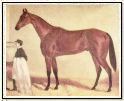
|
| Archer
|
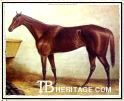
|
| Barbelle
|
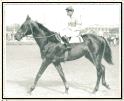
|
| Dalray
|
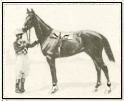
|
| Star Stranger
|
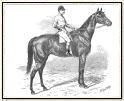
|
| Strathmore
|
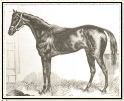
|
| The Barb
|
|
|
Archer b.c. 1856
(William Tell - Maid of the Oaks )
Stockman and horseman Andrew Badgery of Exeter Farm at Jembaicumbene, near Braidwood, and Thomas Molyneux Royds, owner of Ballaba station, related by marriage, formed a breeding partnership, and in 1845 purchased Maid of the Oaks (by Vagabond) at the dispersal of Charles Smith's Clifton Stud. William Tell, imported in February 1847 by Royds, stood at Exeter Farm, where he got Archer and his sister Our Nell, as did another Royds import, the stallion Sailor, who got Archer's half-brother, Mariner. Archer was trained at Terrara by Etienne de Mestre, who set up a stud, stable and race track where unofficial races were held in Terrara. He took Archer the 500 plus-miles to Melbourne by ship to run in the inaugural running of the Melbourne Cup which offered the largest purse for a race in Australia to that time. In a race where two horses were killed, Archer, a Sydney "outsider" who drew scant favor in the betting, won the race, beating a local favorite, Mormon, in a field of seventeen starters. The next day he won the two mile Melbourne Town Plate. Archer was back at Flemington the next year to win the Melbourne Cup again, a feat not repeated until Peter Pan won the race twice more than seventy years later. Because he had failed to respond to his acceptance in time for the Cup the following year, de Mestre and Archer were refused permission to enter the race a third time; entries from other states pulled their horses in protest of this decision, and only seven horses ran in that third Melbourne Cup race. Archer went on to race through 1865, winning in Melbourne and Sydney. De Mestre went on to win three more Melbourne Cups -- with Chester, Calamia, and Tim Whiffler, another feat not replicated until trainer Bart Cummings did it in the 1970s. Archer ran in de Mestre's name, but Royds descendants have always claimed that their family owned the horse, who served as a stallion at Exeter Stud and, it is said, is buried at a family property at Braidwood. Archer's sister, Our Nell, was a sturdy, good racemare that won three races in four days at the Goulburn races, and other races at various city tracks.
Dalray b.c. 1948
(Balloch - Broiveine)
Bred at Sir James Fletcher's Alton Lodge Stud, south of Auckland, this famous New Zealand stayer was by imported Balloch (Obliterate-Cinna), and was largely responsible for his sire's champion stallion status in 1951-52. Purchased as a yearling by Riccarton trainer Clarrie McCarthy, "despite rather ugly joints and a scar," he was resold to Cyril Neville, one of McCarthy's patrons, and ran in the iconoclastic Neville's colors throughout his career. Useless at age two, the following season he proved to be the best in New Zealand and was also highly placed in the big staying races in Australia. His wins in New Zealand included a 2-1/2 length victory in the New Zealand Derby, the 12 furlong Wellington Gloaming Stakes and the Trentham Stakes, the WRC Autumn Handicap, carrying 8 st. - 9 lbs., the 1-3/4 mile New Zealand St. Leger, and a second in the Wellington Cup to Reformed (1946, another member of Family C - 3). In Australia he won Randwick's Autumn Stakes, and then failed by a nose to win the Sydney Cup after a very slow start that left him 100 yards behind the field. The next year he won races in Australia under heavy weights, including the Melbourne Cup (9 st-8 lbs., the only four-year-old to win the race previously with so much weight was Phar Lap; Reformed was third in this race); his other wins included the AJC Collin Stephen Stakes and the 13 furlong Metropolitan Handicap two days later, and the VRC Mackinnon Stakes and VRC Queen's Plate. Retired after a breakdown in Melbourne, he stood briefly there, but was a vicious breeder in his first season, and was happily leased to Queenslander C.E.B. Barnes, who schooled him properly. Dalray remained a stallion at Barnes' Canning Downs Stud in Queensland, where he got some good stayers, including Tails (Family C - 24), winner of two Metropolitan Handicaps and $200,000 in his career. His gelded half-brother Dalstar (by Count Rendered) won the STC Winter Cup. A recent representative descending from his grandam, Lady Alice (1919) is the good filly Giovana (1996, by Blues Traveller - Tristaine), winner of the QTC Queensland Oaks (2400 meters), the WaikRC International Stakes, The WRC Thorndon Mile, and the ARC Oaks Stud Classic, among others.
Gasbag br.c. 1917
(Demonsthenes - Lady Cilia)
One of the top staying three year olds of his generation, raced by Gisborne landowner A.B. Williams, who also owned Star Stranger (see below), he ran second the his generational rival Duo in the New Zealand Derby and the Canterbury Cup (at that time 2 -1/4 miles), and won the Great Northern Derby, but was second to Duo in the New Zealand St. Leger and third to Duo and New Zealand Oaks winner Isabel in the Great Northern St. Leger. The next season he won the WRC Autumn Handicap and triumphed in the Canterbury Cup.
Hag to Hag b.c. 1906
(Perth - Haulette)
His dam, Haulette (Haut Brion - Novelette II), bred by retail tycoon Sir Samuel Horden at Bowral in the southern highlands of Australia, won the AJC Champagne Stakes as a juvenile and the VRC Oaks the following year. French-based distillery baron James Hennessy personally selected her for his French stud, and imported her into France in 1904. Barren in 1905, the following year she produced Hag to Hag, by Perth, who would become a three-time leading sire in France. Raced by Hennessy and trained by Albert Jacquemin, the small-sized Hag to Hag ran in the best company. He started well by winning one small race and then the Prix la Rochette as a juvenile, but after that failed to place. He ran eleven times at age three, winning the Grand Prix de Bruxelles, running third in the Prix Miss Gladiator, in the Prix Mackenzie Grieves and in the Furstenberg Memorial at Baden Baden (2300 meters), but failed to place in the Prix du Jockey Club, the Grand Prix de Paris, or other big races of the season until his utterly unexpected win of the Prix du Conseil Municipal (2400 meters) in the fall, beating some outstanding horses, including the great Ronde de Nuit, who ran second. In the stud he became a useful sire of jumpers.
Hilda b.f. 1885
(Musket - Ouida)
Bred in New Zealand in the Morrin Wellington Park Stud, and raced by Tom Morrin, she was a really sturdy runner, winner of the inaugural ARC Auckland (Great Northern) Guineas, the ARC Easter Handicap in 1890 carrying the record weight of 9 st - 11 lbs., and the Hawkes Bay Cup, and ran second behind Lochiel in the Auckland Cup, later placing third (1889) and second (1890) in the same race. Retired to Wellington Park, she bred three stakes winning stayers --the brothers Antares (1893) and Fulmen (1894), winners the the Auckland Cup and New Zealand Cup respectively, and Lady Lucy (1905, by Seaton Delaval), who also won the New Zealand Cup and was later the dam of VATC Coongy Handicap winner Naos and of the ARC Oaks winner Star Lady. Her daughters, Heorthen and Maude (dam of Mahutonga, see below), also bred on. Hilda's sister half-sister Hazel (by Nordenfeldt), won the CJC Great Autumn Handicap, and became second dam in tail-female of Undecided, a great Cup horse of 1911-1912.
Mahutonga ch.g. 1900
(Quilt - Maude)
Mahutonga was a pretty good stayer who was owned at one time by James Carroll (aka Timi Kara), the first Maori Minister of the Crown, who rode successfully in races at Poverty Bay and Hawke's Bay when young, and was later influential in New Zealand racing club formation and who served as president of the Gisborne Racing Club. He apparently gave away horses, including Mahutonga, to various friends and relatives. Mahutonga, running in the colors of Gisborne settler C. Wallis, won the 1904 Auckland Cup, and the CJC Winter Cup and Metropolitan Handicap, and in 1905 the Auckland Plate, running second to Putty in the Auckland Cup that year.
Queen's Pal b.f. 1979
(Palatable- Lomond Queen)
Bred and raced by Mrs. F. Griffin, who also bred her dam and grandam, she was the leading filly in southern New Zealand at age three, and was among the top four fillies of her year in the country. She won two races at age two, including the CJC Great Western Champagne Stakes (1200 meters), and twelve races (all Listed) at age three, her best distance 1600 meters, which included the North Canterbury Inglewood Stakes, the Oamaru JC Waitaki Stakes, and the Otago RC Mannequin Stakes, although she won twice at 2000 meters (CJC Galaxy Stakes and CJC Warstep Stakes). Her placings included a second in the Southland RC Ascot Park Stakes and a third in the New Zealand One Thousand Guineas. Her dam, Lomond Queen, won five races between 1400 and 2200 meters, including the Otago RC Birthday Handicap and the CJC Aylesbury Handicap. Queen's Pal bred four runners and two winners, including Royal Fling, a winner of three races up to 1400 meters, including the CJC New Zealand Metropolitan Trotting Club Handicap, and Royal Recluse, a winner of five races to 2,000 meters, including the CJC Racecourse Hotel Handicap.
Star Stranger b.g. 1922
(Martian - Star Lady)
A son of the 1919 Great Northern Oaks winner Star Lady, Star Stranger raced for A.B. Williams, who was a big landowner on the east coast of New Zealand, based at Gisborne. As a juvenile he won a maiden plate at Avondale and a Queen's Plate at Auckland. He stepped up in the 1925-26 season, winning some of the most important races for three-year-olds and others against older competition, including the Great Northern Derby, the New Zealand St. Leger; these wins help put his owner at the top of the owner's list in New Zealand that season. He continued as an excellent stayer, winning the WRC Autumn Handicap, the Hawkes Bay Cup (dead-heat), and the AJC Metropolitan Handicap at Randwick in Australia. He was the leading money-winner in New Zealand in the 1927-28 season, taking the Wellington Cup, the Auckland Racing Club Handicap, the Awapuni Gold Cup, and the Trentham Gold Cup over 2 miles in Australasian record time, and placing second by two lengths to Rapier in the New Zealand Cup, carrying 9 st-4lbs. to Rapier's 7 st-12lbs. He raced through 1930, winning the Trentham Gold Cup again that year, and in 1929 losing by a heart-breaking head to Concentrate in the Auckland Cup.
Sweet Nell br.f. 1900
(Haut Brion - Novelette)
The best race mare in Australia in the 1903-04 season, and one of the top of her generation, she was named for the stage actress Nellie "Sweet Nell" Stewart by her breeder, Sir Rupert Clarke, whose 800 acre Kismet stud at Sunbury, Victoria, was located near the family seat of Rupertswood. Clarke took his father's seat in the Colonial Bank of Australia and was involved in various other business ventures, including a fond interest for the theater, co-founder and later director of a company that played at the Theatre Royal in Melbourne. In addition to vast acreages in NSW and Queensland, he owned houses in Melbourne and Sydney, two country properties in England, and the Villa Les Abeilles in Monte Carlo; his son, also Sir Rupert, was an important patron of the turf. Trained by the famous James Scobie, who also schooled the horses of Clarke's brother, Ernest (later founder of Melton Stud), at age two Sweet Nell won the VRC Sires' Produce Stakes, the VRC Flemington Stakes and the SAJC South Australian Stakes. At age three she won the VATC Caulfield Cup and Caufield Guineas double, the VRC Oaks, and was second to her stablemate FJA in the VRC Derby (beating Ernest Clarke's Emir), and in 1904 won the AJC Autumn Stakes and the Wycombe Stakes. Retired to stud, she produced Uncle Matt (1909, by Ernest Clarke's stallion Curtain Lecture), who won the TTC Launceston Cup and the VRC Hotham Handicap. Sweet Nell's sister, Haulette (1897, see above), was another good filly.
Strathmore br.c. 1888
(Nordenfeldt - Ouida)
Bred at the Wellington Stud and originally named Halbert, Strathmore was a top three-year-old in Australia. He was purchased by W.R. Wilson, owner of St. Albans Stud, which had been established at Geelong, Victoria, in the 1860s by the great trainer James Wilson, who was not related to its later owner, W.R. Wilson. W.R. was a leading owner of the 1890s: he also owned Carbine's great son, Wallace, and Caulfield Futurity stakes winner Resolute, and bred the great mare Wakeful while her sire, Trenton stood at stud at St. Albans. Strathmore's wins included the VATC Caulfield Guineas, the VRC Victoria Derby, the CRC St. Leger Stakes and AJC St. Leger Stakes, and the VRC Foal Stakes and Champion Stakes. In the stud he got Avalon (WATC Perth Stakes and others) and Nuncio (VATC Eclipse Stakes and others), but not much else.
The Barb blk.c. 1863
(Sir Hercules - Fair Ellen)
Legendary racehorse known as "The Black Demon," he won 16 of his 21 starts over six furlongs to three miles, including the AJC Derby, the Melbourne Cup, the AJC Metrpolitan, the AJC Craven Plate, the AJC Randwick Plate, the VRC Royal Park Stakes, and the Sydney Cup, twice. A small, jet black colt with "perfect shoulders and the best of legs," he was bred by George Lee at Leeholme, Bathurst, NSW, who owned vast amounts of acreage, raising shorthorn cattle and horses. There is a story that The Barb and Fair Ellen were among some thoroughbred mares stolen, and were tracked to the Cooma district by Henry Lee and Charles Tindale, who caught the thief and recovered the mares, but Ellen's black foal was missing; he was found a few days later, some 20 miles from Bathurst, at a ranch where he had been left by the thief when he became "sore-footed." The Barb was purchased at the Lee yearling sales by "Honest" John Tait, a leading owner-trainer in Australia. He was fractious in his early juvenile races, and sometimes temperamental in races later in his career which cost him some victories, but at age three was the best of his generation, and at age four won his first Sydney Cup, among others, establishing a race record; at age five he was undefeated, winning seven races, including the AJC Great Metropolitan Stakes, setting an Australian record, and a second Sydney Cup carrying 10 st-8 lbs. He ran while some other great horses were on the turf, including Tim Whiffler, who he beat a number of times, and Fishhook. After his retirement he was sold to Charles Reynolds and stood at Tocal Stud, Patterson, in the Hunter Valley, where, despite his own success on the turf, he failed to get any really good runners, although his daughters were influential broodmares, including Melody, the dam of Wallace, Carbine's best son in Australia and later an important sire. He died at Mitta Mitta in 1888, age 25. His sister, Barbelle, just as versatile as he, won the AJC Doncaster Handicap, the VRC Flying Stakes (6 furlongs) three times, and the Sydney Cup. His brother, Barbarian, got the 1881 Melbourne Cup winner Zulu (Colonial Family C-16).
|
|
Bold=winners of stakes races and important handicap and weight-for-age races
Cutty Sark (ch.f.) [imported 1826 from England]
Bonnie Lass (f. 183-) by Bachelor
| Mare (f.) by Zohrab
| Maid of the Oaks (f.) by Vagabond
| Our Nell (f. 184-?) by William Tell
| | Our Kate (f. 185-?) by Punjab
| Archer (b.c. 1856) by William Tell
| Mariner (b.c. 1854) by Sailor
Bet Hyatt (f. 1833) by Batchelor
| Barefoot (c. 1837) by Theorem
| Charles O'Malley (c. 1838) by Rous' Emigrant
| Lanercost (c. c1844) by Sir Charles
Deception (f. 1838) by Theorem
| Gulnare (b.f. 184-) by Gohanna
| Ultima (f. 18--) by Doctor
| | Hussey (f. 1870) by Yattendon
| | Here's Luck (g. 1880) by Kingsborough
| | Lady Kingsborough (f. 1885) by Kingsborough
| | | Kinglock (c. 1898) by Lochiel
| | | Kensington (c. 1899) by Lochiel
| | Lady's Luck (f 1888) by Kingsborough
| | | Scallywag (f. 1893) by Trident
| | Hobrook (c. 1894) by Lochiel
| Fair Ellen [also called Y. Gulnare] (f. 1853) by Doctor
| | The Barb (blk.c. 1863) by Sir Hercules
| | Barbelle (ch.f. 1865) by Sir Hercules
| | Barbarian (blk.c. 1866) by Sir Hercules
| Gulnare (ch.f. 1861) by Little John II
| | Ouida (br.f. 1879) by Yattendon
| | | Artillery (c. 1883) by Musket
| | | Balista (f. 1884) by Musket
| | | | Manutuki (f. 1893) by Castor
| | | | Pink 'Un (c. 1902) by Strowan
| | | Hilda (b.f. 1885) by Musket
| | | | Antares (b.c. 1893) by Castor
| | | | Fulmen (br.c. 1894) by Castor
| | | | Maude (br.f. 1895) by St. Leger
| | | | | Mahutonga (ch.g. 1900) by Quilt
| | | | | Eduam (b.f. 1904) by San Fran
| | | | | | Labour Day (blk.f. 1908) by Soult
| | | | | | | Merry Day (br.f. 1918) by Merry Moment
| | | | | | | Maereana (ch.f. 1933) by Valls
| | | | | | | Reformed (ch.g. 1946) by Probation
| | | | | | Alteration (c. 1913) by Elevation
| | | | | | Edulof (f. 1924) by Danilof
| | | | | | Teasof (f. 1936) by Kiosk
| | | | | | | Riby Grove (f.1944) by Leighon
| | | | | | | Fleet Special (f. 1950) by Trench Flight
| | | | | | Edeforte (f. 1939) by Broiefort
| | | | | | Canon (b.g. 1952) by Cassock
| | | | | Kopu (c. 1905) by San Fran
| | | | | Mangaoroa (f. 1907) by San Fran
| | | | | Pareaurau (f. 1920) by Demosthenes
| | | | | Aroma (f. 1929) by Arausio
| | | | | Te Marua (f. 1937) by Croupier
| | | | | Princess Neptune (f. 1951) by Neptune
| | | | | Queen Neptune (f. 1963) by Black Star
| | | | | Lomond Queen (f. 1971) by Lomond
| | | | | Queen's Pal (b.f. 1979) by Palatable
| | | | Heorthen (f. 1903) by Phoebus Apollo
| | | | | Bonne Bouche (f. 1910) by Boniform
| | | | | Keel Row (f. 1921) by Gay Lad
| | | | | Gay Robe (f. 1929) by Robespierre
| | | | | | Gay Paper (f. 1937) by Paper Money
| | | | | | Rohan June (f. 1948) by Red Mars
| | | | | | Cheri Suisse (f. 1968) by Turon
| | | | | | Firpo (g. 1973) by Pep
| | | | | Rebel Lad (g. 1931) by Robespierre
| | | | Lady Lucy (b.f. 1905) by Seaton Delaval
| | | | Warstar (f. 1914) by Maniapoto
| | | | Star Lady (b/br.f. 1915) by Demosthenes
| | | | | Star Stranger (b.g. 1922) by Martian
| | | | | |Lady Star (ch.f. 1926) by Chief Ruler
| | | | | | Star Lass (b.f. 1936) by Siegfried
| | | | | | Silver Gull (:gr.f. 1944) by Nizami
| | | | | | Silver Wave (b.f. 1952) by Balloch
| | | | | | Yamanami (b.f. 1961) by Golden Wave
| | | | | | Yamanin Wave (b.c. 1967) by Lavandin
| | | | | Chief Star (f. 1927) by Chief Ruler
| | | | | Chief Watchman (g. 1938) by The Night Patrol
| | | | Lucinette (b.f. 1920) by Martian
| | | | | Lucy Limond (br.f. 1927) by Limond
| | | | | | Lucetta (ch.f. 1931) by Captain Bunsby
| | | | | | Crimson King (ch.c. 1948) by Balloch
| | | | | | Balfast (ch.g. 1853) by Balloch
| | | | | Imogen (f. 1935) by Siegfried
| | | | | Gay Senorita (f. 1942) by Gynerium
| | | | | Gay Minstrel (c. 1948) by Kentucky
| | | | Naos (c. 1921) by Martian
| | | | Lucinda (b.f. 1922) by Martian
| | | | Honeste (b.f. 1931) by Honour
| | | | | Leal (br.f. 1940) by Man's Pal
| | | | | Della Rosa (ch.f. 1947) by Defaulter
| | | | | Rodella (b/br.f. 1954 by Beau le Havre
| | | | | Tamboura (br.c. 1973) by Papillion
| | | | Proven (f. 1938) by Solicitor General
| | | | Master Proven (g. 1948) by Isaac of York
| | | | Cardigan (c. 1952) by Ruthless
| | | Hazel (f. 1887) by Nordenfeldt
| | | | St. Amy (f. 1897) by St. Leger
| | | | Undecided (b.g. 1906) by Menschikoff
| | | Strathmore (br.c. 1888) by Nordenfeldt
| | | Brown Alice (f. 1889) by Nordenfeldt
| | | | Lady Augusta (f. 1894) by St. Leger
| | | | | Kelburn (c. 1899) by Hotchkiss
| | | | | Thunderer (c. 1900) by Hotchkiss
| | | | | Multiply (g. 1909) by Multifed
| | | | Aleger (f. 1897) by St. Leger
| | | | | Amalfi (f. 1912) by Positano
| | | | | | Montella (f. 1921) by Cyklon
| | | | | | Pindenda (c. 1923) by Pistol
| | | | | Court Jester (c. 1913) by Comedy King
| | | | Ropa (ch. g. 1900) by St. Leger
| | | | Moogal (f. 1903) by Phoebus Apollo
| | | | Cheddar (g. 1907) by St. Leger
| | | Moth (f. 1890) by Nordenfeldt
| | | | Optimist (c. 1901) by Haut Brion
| | | Novelette (br.f. 1891) by Nordenfeldt
| | | | Haulette (br.f. 1897) by Haut Brion
| | | | | Hag to Hag (b.c. 1906) by Perth
| | | | Sweet Nell (br.f. 1900) by Haut Brion
| | | | Uncle Matt (c. 1909) by Curtain Lecture
| | | Chiara (f. 1894) by Cuirassier
| | | | Walda (f. 1899) by Perkin Warbeck II
| | | | | Mettle (f. 1908) by Calibre
| | | | | Dutch Courage (f. 1916) by Nassau
| | | | | Guilder (f. 1933) by Paper Money
| | | | | Dutch Flag (g. 1950) by Peak Halyard
| | | | Kairamarama (f. 1917) by Marble Arch
| | | | Winrama (f. 1930) by Whirlwind
| | | | Attempt (f. 1939) by Dink
| | | | May Day (f. 1952) by Summertime
| | | | Gay Day (f. 1961) by Gabador
| | | | | Va Bene (f. 1978) by Sovereign Ruler
| | | | | Soldier Blue (ch.g. 1994) by Sir Sian
| | | | Metric System (br.f. 1969) by Trictrac
| | | | Brunisse (br.f. 1977) by El Seetu
| | | Lady Cecilia (br.f. 1895) by Cuirassier
| | | | Alicia (f. 1902) by Cyrenian
| | | | | Prince Charleroi (c. 1916)by General Latour
| | | | | Miss Alicia (f. 1919) by Thurnham
| | | | | Lucky Alice (f. 1926) by Lucullus
| | | | | Broiveine (f. 1939) by Broiefort
| | | | | | Dalray (b.c. 1948) by Balloch
| | | | | | Dalstar (g. 1951) by Count Rendered
| | | | | Eastern Charm (f. 1943) by Nizami
| | | | | | Magic Carpet (c. 1951) by Pherozshah
| | | | | | French Charm (c. 1952) by Gabador
| | | | | Broiedame (f. 1941) by Broiefort
| | | | | | Mydame (f. 1948) by Balloch
| | | | | | Egmont Park (c. 1967) by Copenhagen
| | | | | Netherlee (br.f. 1947) by Hello Peter
| | | | | Nether Gold (br.c. 1952) by Rolled Gold
| | | | | Foglia d'Oro (ch.f. 1954) by Rolled Gold
| | | | | Netherland (f. 1960) by Copenhagen
| | | | | Flat Tax (f. 1965) by Beau Diable
| | | | | | Pacific Isle (br.f. 1975) by Hermes
| | | | | | Tristina (b/br.f. 1981) by Sir Tristram
| | | | | | Sky Danza (b.f. 1987) by Danzatore
| | | | | | Tristaine (b.f. 1990) by Centaine
| | | | | | Giovana (b/br.f. 1996) by Blues Traveller
| | | | | Sporting Fashion (f. 1979) by Avaray
| | | | | Watch Officer (c. 1992) by Starjo
| | | | Serita (f. 1903) by Cardigan
| | | | | Serita Thurnham (f. 1918) by Thurnham
| | | | | Speed Mint (f. 1928) by Catmint
| | | | | | Shining Night (g. 1938) by Foxbridge
| | | | | Senorita (f. 1929) by Whirlwind
| | | | | Black Bridge (f. 1942) by Foxbridge
| | | | | Regal Bridge (f. 1948) by Royal Chief
| | | | | | Reverted (f. 1954) by Super
| | | | | | Meldie (c. 1965) by Bellborough
| | | | | Ocean Lore (f. 1951) by Dogger Bank
| | | | Lady Cilia (f. 1909) by Gold Reef
| | | | Gasbag (br.c. 1917) by Demosthenes
| | | | Kaahumanu (f. 1920) by Demosthenes
| | | | | Jacquette (f. 1929) by Magpie
| | | | | Indian Gold (c. 1941) by Bulandshar
| | | | | | Jaconet (f. 1945) by Bulandshar
| | | | | | Net (f. 1951) by Faux Tirage
| | | | | | | Double (f. 1958) by Daily Double
| | | | | | | Twice (f. 1974) by Keekerok
| | | | | | | Our Caddy (f. 1985) by Cocky Golfer
| | | | | | | Fairway (br.g. 1996) by Danzero
| | | | | | Azuri (f. 1954) by Faux Tirage
| | | | | | | Medici (c. 1968) by Bourbon Prince
| | | | | | Half Volley (f. 1956) by Faux Tirage
| | | | | | Rototane (b.f. 1958) by Faux Tirage
| | | | | | Rotorangi (f. 1971) by Final Orders
| | | | | | Silver Mover (b/br.f.1977) by Silver Dream
| | | | | | Fine Row (b/br.f. 1980) by Long Row
| | | | | | Winged Foot (ch.g. 1991) by Raami
| | | | | Kalika (f. 1934) by Constant Son
| | | | | Lajani (f. 1944) by Nizami
| | | | | Purdah (f. 1954) by Faux Tirage
| | | | | Promise (f. 1972) by Final Orders
| | | | | Pawky (g. 1976) by Acharacle
| | | | | Purdah Gold (f. 1977) by Acharacle
| | | | | Purdah's Pride (c. 1985) by Western Bay
| | | | Saucy Lass (f. 1923) byTea Tray
| | | | Whakatara (f. 1930) by Romeo
| | | | Mettle (f. 1944) by Valiant Chief
| | | | Sidora (f. 1949) by Macarthur
| | | Lady Helen (f. 1896) by St. Leger
| | | Lady Nell (f. 1903) by Birkenhead
| | | Lord Multifid (c. 1911) by Multifid
| | Girofle (f. 1880) by Yattendon
| | Girofla (f. 1890) by Damit
| | | Horologist (c. 1899) by Medallion
| | | Sir Simmer (c. 1901) by Simmer
| | Cow Grass (f. 1896) by Trenton
| | Lucerne (f. 1903) by Sir Tristram
| | Prairie Maid (f. 1910) by Bobadil
| | | Lin Maid (f. 1915) by Linacre
| | | Lady Eleven (f. 1932) by Treclare
| | | Lady Dinah (f. 1946) by Coronation Day
| | | Rain in Spain (f. 1957) by Prince Goldsborough
| | | Dinah's Daughter (f. 1959) by Prince Goldsborough
| | | Solo Girl (f. 1967) by Tourmaline
| | | Solo Lad (g. 1978) by The Toddler
| | Wheatacre (f. 1917) by Linacre
| | Sweet Heroic (f. 1930) by Heroic
| | Roxford (g. 1937) by Roxburgh
| | Tip Toes (f. 1941) by Beau Pere
| | Come Inn (f. 1950) by Wayside Inn
| | Tutu (f. 1951) by Genetout
| Gulnare (f. 1862) bySir Hercules
Troll (f. 1840) by Lawson's Emigrant
Tros (c. 1842) by Tros
Cain (c. 1843) by Vagabond
Marske (c. 1844) by Vagabond
|
|
|

